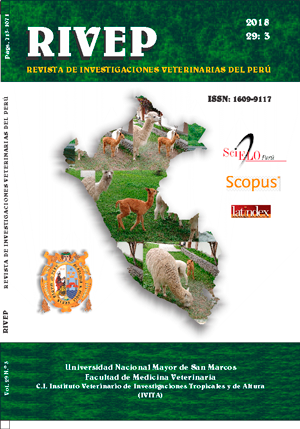Genetic diversity of the population of domestic cats (Felis catus) of the city of Mompox, Bolivar, by coat markers
DOI:
https://doi.org/10.15381/rivep.v29i3.14830Keywords:
Felis catus, genes, allelic frequencies, Hardy-Weinberg equilibrium, genetic distanceAbstract
The study was conducted to analyze the genetic diversity of the population of cats (Felis catus) of the Colombian city of Mompox, Bolívar. The following genes were studied: Orange, Agouti, Tabby, Dilution, Long Hair, Spotting White Dominant White, Manx and Siames for 200 cats in five neighborhoods of the city. Mompox presented allelic frequencies that ranged between 0.678 and 0.003 for the Non-agouti and Manx markers, respectively. The Spotting White and Long Hair markers showed the greatest diversity; the Orange marker presented disequilibrium in two populations: Seis de Agosto and Faciolince, while Spotting White maintained a Hardy-Weinberg equilibrium. A high genetic differentiation was found between the populations (GST = 0.1283). In Mompox an association of the populations was presented attending the date of their foundations. In the Colombian Caribbean, the populations were grouped according to the political estates erected since the colonization and according to the times of the foundations of the cities; In addition, they were grouped by their geographical proximity.Downloads
Downloads
Published
Issue
Section
License
Copyright (c) 2018 Enrique Pardo, Andrés Castro, Mauricio Begambre

This work is licensed under a Creative Commons Attribution-NonCommercial-ShareAlike 4.0 International License.
AUTHORS RETAIN THEIR RIGHTS:
a. Authors retain their trade mark rights and patent, and also on any process or procedure described in the article.
b. Authors retain their right to share, copy, distribute, perform and publicly communicate their article (eg, to place their article in an institutional repository or publish it in a book), with an acknowledgment of its initial publication in the Revista de Investigaciones Veterinarias del Perú (RIVEP).
c. Authors retain theirs right to make a subsequent publication of their work, to use the article or any part thereof (eg a compilation of his papers, lecture notes, thesis, or a book), always indicating the source of publication (the originator of the work, journal, volume, number and date).



